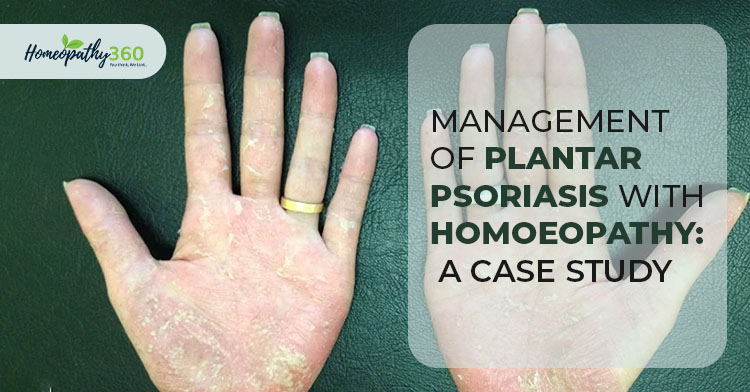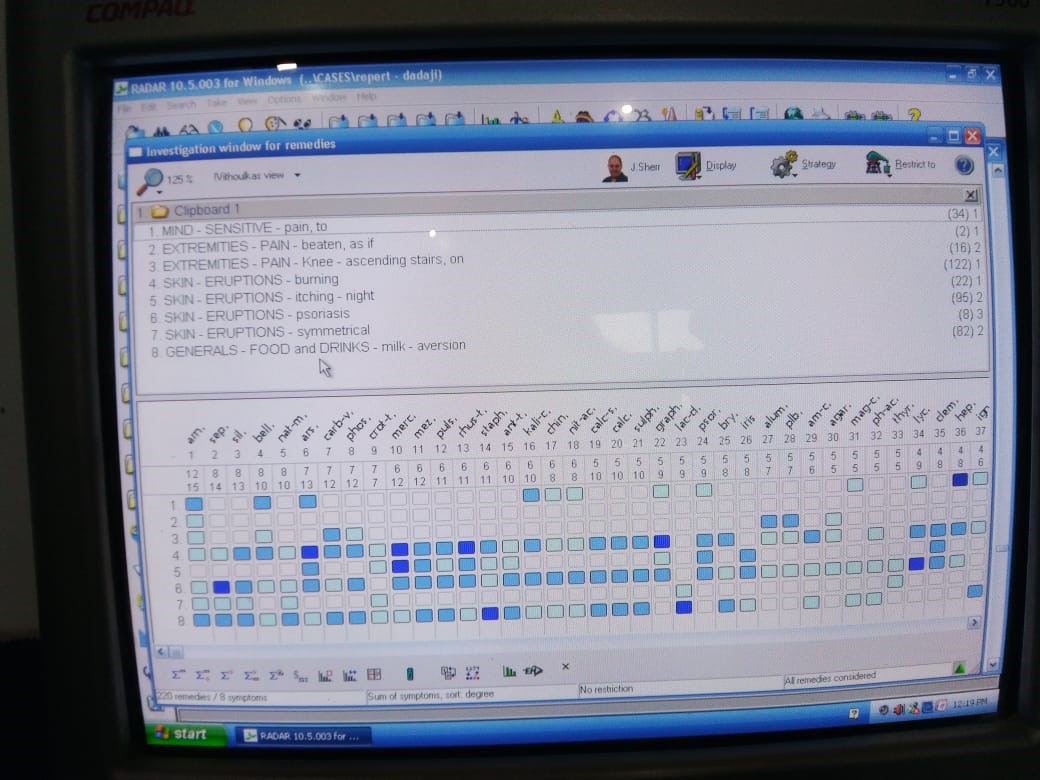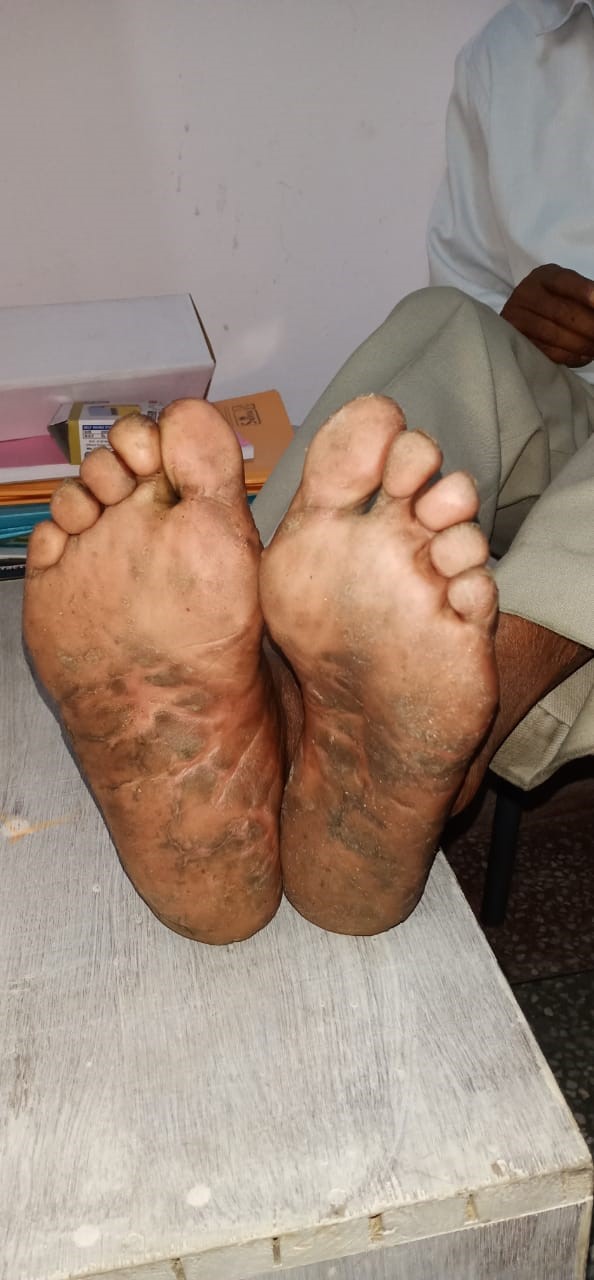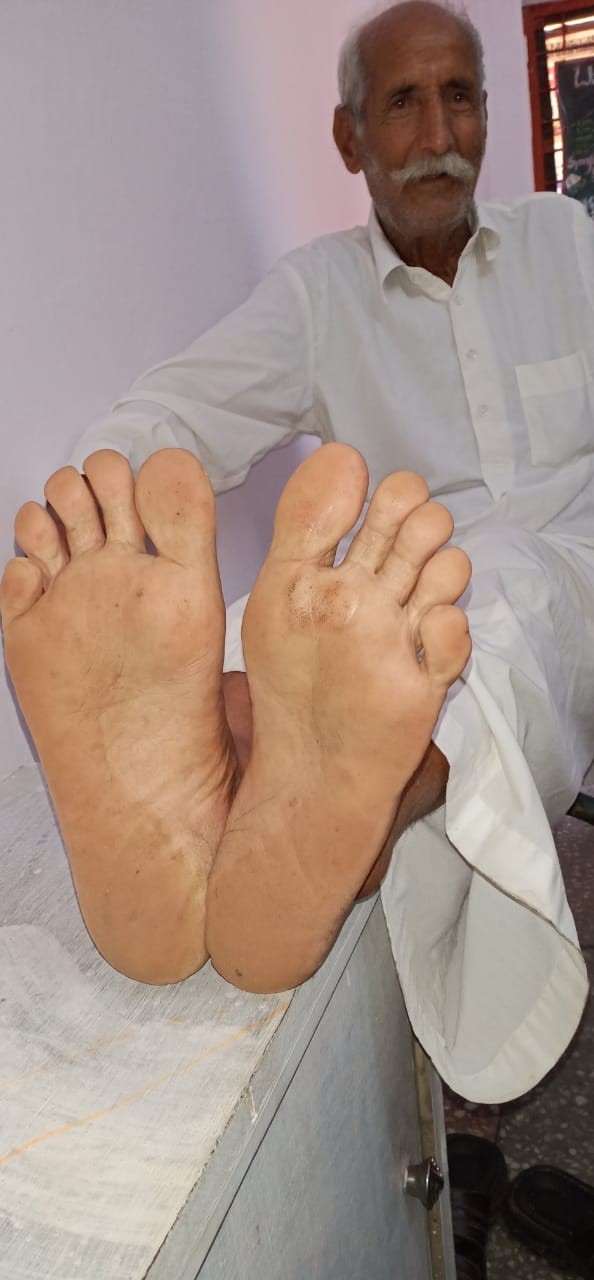
Management Of Plantar Psoriasis With Homoeopathy: A Case Study
Abstract
Palmoplantar psoriasis is a chronic, autoimmune disease characterised by the rise of desquamative plaques on the palms and soles. Due to the thick stratum corneum of the palmoplantar regions, the search for effective topical treatments has been significantly more difficult than other forms of psoriasis. A case of 60 years old male suffering from plantar psoriasis here treated successfully within 6 months by a single individualised homoeopathic medicine Arnica montana 30 with minimum repetitions. There was remarkable improvement in a very short period of time. The case was observed for 2 years without recurrence which suggests that permanent cure is achievable through single and simple individualised homoeopathic treatment.
Keywords
Psoriasis, palmoplantar psoriasis, Arnica montana, homoeopathy
Abbreviations
PPP: palmoplantar psoriasis
PPPASI: palmoplantar psoriasis area and severity index
Introduction
Psoriasis is a chronic, recurring autoimmune disease that triggers the rise of scaly, red lesions on the skin, affecting approximately 2% of the global population. One clinical subtype of psoriasis localized on the palms and soles is classified as palmoplantar psoriasis (PPP). PPP affects approximately 14% of patients diagnosed with psoriasis. Characteristic effects include the formation of scaly erythematous plaques on the palms and soles, accompanied with scaling and keratinization [1]. Resulting lesions from PPP lead to functional impairments in daily activities that cause social and psychological distress. Compared to other forms of psoriasis, the disease’s occurrence on the palms and soles causes a significantly greater decrease on patient’s quality of life [2]. Interleukin 17 (IL-17) plays a significant role in the pathogenesis of this variant of psoriasis compared with other forms of psoriasis. Patients with PPP treated with systemic biologics targeting IL-17 tend to have favourable results [3]. Studies have attributed PPP to stem from physical activity involved in occupation. External factors correlated with manual labour, stemming from interactions with friction and mechanical stimuli, cause psoriatic lesions to become localized in pressure bearing areas [1,4].
The palmoplantar psoriasis area and severity index (PPPASI), is a point-based system quantifying the area and quality of PPP. The PPPASI measures erythema, induration, and desquamation on a scale of 0-4, 4 being the most severe. The PPPASI score is widely used as a measure of improvement in many clinical studies. Some studies, however, will not refer to the PPPASI, but will measure similar symptoms using a point-based scoring system [5].
Following is a case of plantar psoriasis treated successfully with homoeopathy. Her informed consent was taken.
Case report:
Personal Data:
Name: Mr A
Age/Sex: 60years/ male
Marital Status: Married
Address: Dehradun
Dated: 20-08-2019
Presenting complaints:
- Patient
was having dry scaly patches on soles of both foot since 2years.
- Location: soles of both foot
- Sensation: Itching with burning
- Modalities: Aggravation- least touch, night
Amelioration: coconut oil application
- Patient
presented with pain in both knee joint since 1year.
- Location: both knees
- Sensation: Pain as if beaten
- Modalities: Aggravation- walking, ascending stairs
Amelioration- rest
History of presenting complaints:
Patient was apparently well two years back then gradually he noticed dryness of skin on the soles which was symmetrical in origin and present on both soles which gradually increased over a period of time into dry scaly patches with itching and burning which is aggravated by least touch.
Patient was also presented with bilateral knee pain since 1year aggravated by ascending stairs and walking which gets ameliorated by rest. Treated with allopathic medicine with temporary relief.
Personal history:
Suffered from typhoid 7 years ago treated with allopathic medicine
Family history:
History of psoriasis (Father)
History of rheumatoid arthritis (Mother)
Physical generals:
- Appetite: Adequate, regular, 3 times / day
- Thirst: Thirsty for normal water with 2-3 litres/day
- Desire: Spicy food
- Aversion: Milk
- Intolerance: Alcohol causes diarrhoea
- Urine: Normal, clear, non-offensive
- Stool: Satisfactory, soft, regular, offensive
- Perspiration: Generalised, non-staining, non-offensive
- Sleep: Disturbed due to itching
- Dreams: of death
- Thermal reaction: Ambithermal
Mental generals:
- Wanted to be alone when angry
- Desire for company
- Oversensitive to pain
- Desire for doing work
Analysis and evaluation of symptoms:
| Physical generals(intensity) | Desire for spicy food+ | Aversion to milk++ | Intolerance for alcohol causing diarrhoea++ | Sleep disturbed due to itching++ | ||
| Mental generals(intensity) | Desire solitude when gets angry++ | Desires company+ | Over sensitiveness to pain++ | |||
| Particulars(intensity) | Dry scaly eruptions on both soles+++ | Sensation of itching at night++ | Sensation of burning++ | Aggravated by least touch++ | Pain in both knees++ | Aggravation- walking+, ascending stairs++ |
Provisional diagnosis
Plantar psoriasis [6]
Totality of symptoms:
- Dry, scaly patches on both soles of foot
- Dry, scaly eruptions with itching, aggravated at night
- Dry, scaly eruptions with burning
- Dry, scaly eruptions aggravated by least touch
- Pain in both knees
- Pain aggravation by walking and ascending stairs
- Aversion to milk
- Intolerance to alcohol causes diarrhoea
- Sleep disturbed due to itching
- Desire for solitude when angry
- Over sensitiveness to pain
Rubrics [7]:
- mind – sensitive – pain, to
- extremities – pain – beaten, as if
- extremities – pain – knee – ascending stairs, on
- skin – eruptions – burning
- skin – eruptions – itching – night
- skin – eruptions – psoriasis
- skin – eruptions – symmetrical
- generals – food and drinks – milk – aversion
Analysis of the case:
After analysis and evaluation of the case, the characteristic symptoms were used to form the totality, “dry, scaly eruptions on both soles of foot accompanied by itching at night and burning, aggravation by least touch, pain in both the knees as if beaten were some important particulars of the case”. “Aversion to milk, intolerance to alcohol causes diarrhoea were important physical generals” and desire for solitude and over sensitiveness to pain were included in the mental generals.
The selection of the remedy was based on the repertorisation from RADAR 10 software [7] using Synthesis treasure edition, 2009 by Frederick Schroyens with repertorial result showing top five remedies as Arnica montana, Sepia officinalis, Silicea terra, Belladonna and Natrum muriaticum from which Arnica montana scored highest covering all the eight rubrics.

Prescription:
Arnica montana 30/ 4 doses
Basis of prescription:
After analysing the reportorial result and consultation with Boericke’s Materia Medica [8] and Allen’s Keynotes [9], Arnica montana 30 was prescribed (including symptoms such as over sensitiveness to pain, dry scaly eruptions on both soles of foot associated with sensation of itching and burning, aversion to milk, pain in bilateral knee joint with sensation as if beaten, etc). Arnica montana was selected on the basis of bilateral symmetry of the complaints as stated in the Boericke’s materia medica [8]. Arnica montana 30 was given in 4 doses after which the patient showed slight improvement followed by placebo. The prescription was repeated every month according to the condition of the complaints for six months followed by placebo.
Potency: Third to thirtieth potency. Locally, the tincture, but should never be applied hot or at all when abrasions or cuts are present.
Follow Up:
| DATE | SYMPTOMS | MEDICINES |
| 20-08-2019 | Patient Ist visit | Arnica montana 30/ 4 doses (“The dose of medicine (of the first prescription) that acts without producing new troublesome symptoms in to be continued while gradually ascending, so long as the patient with general improvement, begins to feel in the mild degree the return to of one or several old original complaints”.) (Aph 248,280) [10] |
| 19-09-2019 | Improvement in scaly eruptions and itching | Placebo |
| 21-10-2019 | Reduction in the dry scaly eruptions but itching and burning persisted, Pain in knee persisted | Arnica montana 30/ 3 doses (According to Kent’s 11th observation, reappearance of older symptoms and the improvement is standstill then the repetition of the remedy should be prescribed) [11] |
| 19-11-2019 | Further improvement in eruptions and itching, pain in knees relieved | Placebo |
| 22-12-2019 | Reduction in the number of eruptions, itching and burning relieved | Placebo |
| 18-01-2020 | Slight improvement in eruptions itching persisted | Arnica montana 30 / 2 doses |
| 19-02-2020 | Eruptions are relieved with clean skin over soles with no associated complaints | Placebo |
| 20-03-2020 | No eruptions persisted | Placebo |
Before

After

Discussion and conclusion:
Homoeopathic medicine selected on the basis of principles of homoeopathy proved to be very effective in this case of plantar psoriasis and shown good results of improvement. Arnica montana was selected on the basis of bilateral symmetry of the symptoms, sensation as if beaten in extremities, physical and mental generals keeping in mind the materia medica and homoeopathic principles. Treatment was continued for 6 months. There was marked improvement after the first prescription continued with placebo for 1 month. Next dose of Arnica was given after 1 month when the improvement became standstill. The doses were repeated after observing the condition of the complaints and progress in the condition of the disease. The patient was observed for 3 years to see if there is any relapsing of the complaint.
The potency selection was done on the basis of susceptibility of the patient as stated by Dr Close [12]
1. The greater the
characteristic symptoms of the drug in the case, the greater the susceptibility
to the remedy and the higher the potency required.
2. Age: medium and higher potencies for children.
3. Higher potencies for sensitive, intelligent
persons.
4. Higher potencies for persons of intellectual
or sedentary occupation and those exposed to excitement or to the continual
influence of drugs.
5. In terminal conditions even the crude drugs
may be required
He also mentioned, “different potencies act
differently in different cases and individuals at different times under
different conditions. All may be needed. No one potency, high or low, will meet
the requirement of all cases at all times.”
Conflicts of Interest: Nil
References
- Bolognia J, Jorizzo JL, Rapini RP (2008) [Accessed on 20 Dec 2021] Dermatology. (2nd edtn). St. Louis: Mosby Elsevier.
- Pettey AA, Balkrishnan R, Rapp SR, Fleischer AB, Feldman SR Patients with palmoplantar psoriasis have more physical disability and discomfort than patients with other forms of psoriasis: implications for clinical practice. J Am Acad Dermatol [Internet] (2003) [Accessed on 20 Dec 2021] 49: 271-275.[Crossref]
- Lee E, Zarei M, LaSenna C, Villada G, Romanelli P Psoriasis Targeted Therapy: Characterization of Interleukin 17A Expression in Subtypes of Psoriasis. J Drugs Dermatol [Internet] (2015) [Accessed on 21 Dec 2021] 14: 1133-1136.[Crossref]
- Kumar B, Saraswat A, Kaur I Palmoplantar lesions in psoriasis: a study of 3065 patients. Acta Derm Venereol [Internet] (2002) [Accessed on 22 Dec 2021] 82: 192-195.[Crossref]
- Linden Li, Taliercio M, Hashim PW, Kimmel G, Farahani AC and Nia JK. Palmoplantar psoriasis: A review of tropical therapies. Glob Dermatol [Internet] 2016. [Accessed on 22 Dec 2021] Volume 3(6): 387-393.
- World Health Organisation (WHO), icd10data.com, 2022 ICD-10 -CM Diagnosis code [Internet], Geneva, Switzerland, World Health Organisation 1993; [Accessed on 25 Dec 2021], https://www.icd10data.com/
- Schroyens F. Radar 10 Homoeopathic Repertory Software. CDROM. Available from: http://www.archibel.com/radar10.html. [Accessed on 25 Dec 2021].
- Boericke W. Pocket Manual of Homoeopathic Materia Medica and
Repertory. 9th Reprint ed. New Delhi: B Jain Publishers; 2007. p- - Henry C A. Keynotes and Characteristics with Comparison of some of the leading remedies of materia medica. [Accessed on 25 Dec 2021] http://www.homeoint.org/books/allkeyn/index.htm
- Hahnemann S. Organon of Medicine. 6th ed. New Delhi: B Jain Publishers; 2002. p. 227-8
- Kent J T. Lectures on Homoeopathic Philosophy. Archive.org [Internet]. Chicago. Ehrhart & Karl, 1919. [Accessed on 26 Dec 2021]. https://archive.org/details/lecturesonhomoe00kentgoog.
- Close S. M. The Genius of Homoeopathy: Lectures and Essays on homoeopathic philosophy. Homoint.org [Internet]. New York. Nanopathy, 1981. [Accessed on 26 Dec 2021]. http://www.homeoint.org/books4/close/index.htm.





